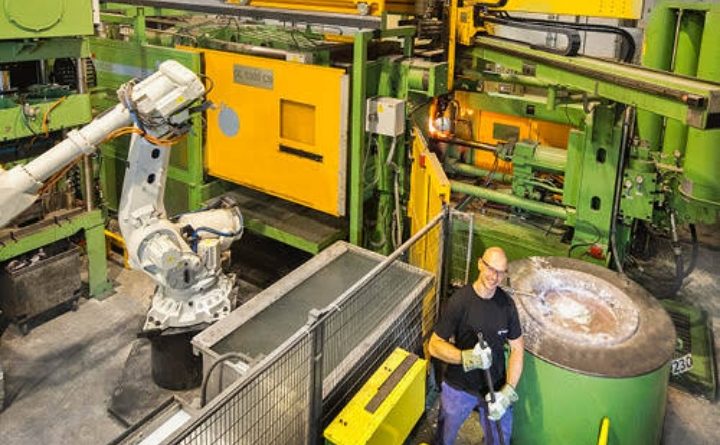What is High-Pressure Die Casting?

Welcome to the intriguing realm of high pressure die casting process! If you’ve ever pondered the intricacies of crafting precise and efficient complex metal parts, this blog post is tailor-made for you. High-pressure die casting, a versatile manufacturing process, has transformed the production of intricate components across various industries. Whether in automotive or aerospace, this technique boasts unparalleled advantages, solidifying its status as one of the most favored methods for crafting metal parts.
So, fasten your seatbelt and prepare to embark on a journey into the intricacies of the high pressure die casting process as we delve into its history, applications, challenges, and future innovations. Brace yourself for the marvels of this remarkable technology!
History and Development of High-Pressure Die Casting
The captivating history of high-pressure die casting spans several decades, originating in the early 19th century when inventors embarked on experiments with diverse casting methods to efficiently produce complex metal parts. A pivotal moment in the evolution of high-pressure die casting occurred with the invention of the hot chamber die-casting machine by American innovator H. W. Doehler in 1914. This groundbreaking machine ushered in faster production cycles and heightened efficiency compared to previous methods.
Over time, progress in materials, machinery, and processes led to further refinements in high-pressure die casting technology. The introduction of cold-chamber machines facilitated the use of non-ferrous alloys like aluminum and magnesium, broadening its applications across industries.
Recent years have witnessed substantial advancements in process control, automation, and computer simulations within high-pressure die casting.
These developments have elevated product quality, minimized waste and defects, and bolstered overall productivity. The continual evolution of high-pressure die casting is spurred by industry demands for lightweight yet durable components in automotive manufacturing, aerospace engineering, consumer electronics production, and various other sectors. As technology rapidly advances, further innovations in high-pressure die casting techniques are anticipated.
These developments, from enhanced cavity-filling techniques to advanced cooling systems for faster solidification rates, are poised to shape the future landscape of this versatile manufacturing process.
The Process of High-Pressure Die Casting
The high pressure die casting process is a highly efficient and precise method used to produce complex metal parts. It involves injecting molten metal, typically aluminum or zinc, into a steel die under extreme pressure. This pressure ensures that the liquid metal fills every nook and cranny of the die cavity, resulting in intricate and detailed components.
To begin the process, the die is preheated to withstand the high temperatures of the molten metal. The two halves of the die are then securely clamped together. Next, a shot sleeve fills with molten metal from a furnace and injects it into the die cavity at incredibly high speeds.
As the molten metal enters the cavity, it quickly solidifies under pressure. Once cooled, ejector pins push against the solidified part to release it from the dies. The cycle can then be repeated for mass production. High-pressure die casting offers numerous advantages over other casting methods.
It allows for tight tolerances, excellent surface finishes, and rapid production rates. Despite its many advantages, high-pressure die casting also has its challenges. Porosity can be caused by trapped air or gas during injection. Equal cooling rates must also be maintained throughout the casting.
In summary, high-pressure die casting is an invaluable manufacturing technique that delivers precision-made components efficiently and economically!
Advantages and Applications of High-Pressure Die Casting
High-pressure die casting is a preferred choice across industries for several reasons:
- Precision and Complexity: It excels in producing complex and intricate parts with high precision, enabling detailed designs that are challenging with other methods.
- Cost-Effectiveness: This process allows for rapid mass production, significantly reducing manufacturing costs. Long-lasting tooling further contributes to cost savings.
- Versatility: High-pressure die casting is versatile and used in the automotive industry for engine components, aerospace for lightweight and durable parts, consumer electronics for intricate casings, and the medical industry for precise instruments and devices.
Overall, the high pressure die casting process offers a cost-effective, precise, and versatile solution for manufacturers seeking to produce high-quality, intricate parts across various industries.
Comparison with Other Casting Methods
One of the main advantages of high-pressure die casting is its ability to produce complex shapes with tight dimensional tolerances, which makes it a highly efficient and versatile casting method. Unlike sand casting or investment casting, which require extensive post-processing to achieve the desired shape, high-pressure die casting can produce near-net shape parts with minimal machining required. High-pressure die casting has another advantage: It is ideal for large-scale manufacturing due to its speed and efficiency.
Steel molds are injected with molten metal at high pressure, resulting in rapid production cycles. Utilizing a steel mold enables the creation of smooth and accurate surfaces without necessitating additional finishing operations. Additionally, high-pressure die casting is characterized by its speed and efficiency.
Furthermore, high-pressure die casting has excellent material properties compared to other casting methods such as gravity or low-pressure die casting. It produces dense parts with fine grain structure resulting in improved mechanical properties like strength and hardness. When comparing different types of casting methods, it becomes clear that high pressure die casting process stands out due to its ability to produce complex shapes efficiently with excellent surface finish while maintaining superior material properties
Challenges and Limitations of High-Pressure Die Casting
High-pressure die casting faces challenges and limitations, including:
- High Initial Investment: Die casting operations require a significant investment in equipment, such as die casting machines and molds.
- Quality Control: Consistent quality throughout the production process is challenging since variations in temperature or pressure can lead to defects.
- Size and Complexity Constraints: High-pressure die casting may have limitations in casting intricate designs or thin-walled parts.
- Material Constraints: Materials with low melting points or poor fluidity are not suitable for high-pressure die casting due to their chemical composition or physical properties.
- Environmental Concerns: As molten metal and energy-intensive methods are used in the process, carbon emissions can result.
Despite these challenges, high pressure die casting process remains a widely used and efficient manufacturing technique, and ongoing innovations aim to address these limitations and enhance its capabilities.
Future Innovations in the Industry
The high-pressure die casting industry is on the cusp of exciting innovations as it adapts to rapid technological advancements. Key areas of focus include:
- New Materials: Exploring alternative alloys with improved properties for diverse applications in industries like automotive, aerospace, and electronics.
- AI Integration: Incorporating artificial intelligence to analyze data and optimize processes in real time for enhanced precision and consistency.
- Automation: Utilizing advanced robotic systems to boost productivity and reduce labor costs.
- 3D Printing: Leveraging 3D printing for faster prototyping and mold customization, which offers design flexibility and shorter lead times.
- Sustainability: Embracing eco-friendly practices to reduce waste and promote recycling in response to global environmental concerns.
The future holds significant promise for the high pressure die casting process, with ongoing research and innovation set to revolutionize manufacturing processes, benefiting both manufacturers and end-users. Exciting times lie ahead!
Conclusion
In conclusion, the high pressure die casting process is a transformative and efficient manufacturing process, particularly suited for the automotive, aerospace, and electronics industries due to its precision and versatility. While its speed and cost-effectiveness distinguish it from other methods, challenges remain for specific materials and intricate designs. Future innovations targeting energy efficiency and eco-friendly materials underscore the continued significance of high-pressure die casting in diverse industries, promising both improved performance and sustainability.
Read Also : What is High-Pressure Die Casting?




